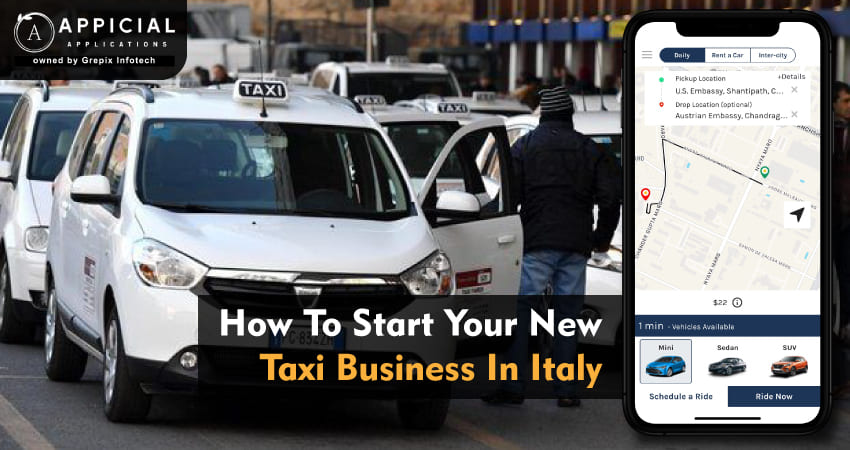
How To Start Your New Taxi Business In Italy
Starting a taxi business in Italy can be a promising venture given the country's bustling tourism industry and its dense urban areas that demand flexible transportation solutions. In this guide, we'll explore the essential steps to launch a successful taxi business in Italy, covering legal requirements, business planning, operational strategies, and marketing.
First, conduct market research to identify demand, analyze competition, and understand customer needs, particularly in urban centers or tourist-heavy areas. Register your business with the local Camera di Commercio and decide on a business structure, such as a sole proprietorship or a limited liability company. Develop a competitive pricing strategy and hire skilled, customer-oriented drivers. Market your business effectively by creating a strong brand, leveraging digital marketing, and optimizing your online presence for local searches. Finally, solicit customer feedback to refine your services, and consider scaling up and diversifying as your business grows.
Establishing a taxi business in Italy can be very profitable, especially because of its booming tourism industry and the ongoing need for adaptable transportation options in its congested cities. It's imperative to start this entrepreneurial journey with thorough market research to ascertain important locations, comprehend local demand, and assess competition. After that, correctly register your business and negotiate the legal system to obtain the required taxi licenses and permits. Selecting the appropriate fleet that complies with local laws is another essential step. By employing powerful branding and digital marketing strategies, your taxi service can differentiate itself from the competition. Put a high priority on customer service by hiring amiable, professional drivers and routinely gathering input to improve your offerings.
Understanding the Italian Transport Sector
Before diving into the taxi business, it's important to understand the landscape of public transportation in Italy. Italy has a well-developed public transport network, including buses, trams, and trains. However, taxis play a crucial role, especially in tourist-heavy cities like Rome, Milan, Florence, and Venice.
Step 1: Market Research
i) Conducting Thorough Market Research
Start with researching the local market needs. Identify which cities have a high demand for taxis and understand the peak hours and key locations such as airports, train stations, hotels, and tourist attractions. Analyze the competition, noting how many taxi companies operate in your chosen area and what services they offer.
ii) Understanding Your Audience
Know your potential clientele. Are they primarily tourists, locals, or business visitors? Each group might have different expectations and service requirements, such as multilingual drivers or luxury vehicles.
Step 2: Legal Requirements
i) Obtaining Necessary Licenses and Permits
The most critical step in starting a taxi business in Italy is obtaining the right licenses. You will need a licenza taxi (taxi license), which is issued by the local municipality. The requirements for obtaining this license can vary by city but generally involve passing a test on local geography and regulations, a medical examination, and a clean criminal record.
ii) Registering Your Business
Register your business with the Camera di Commercio (Chamber of Commerce) in your locality. You'll need to decide on your business structure (e.g., sole proprietorship, partnership, limited liability company) and register for tax purposes.
Step 3: Purchasing and Preparing Vehicles
i) Choosing the Right Vehicles
Select vehicles that are comfortable, reliable, and economical to maintain. Most taxis in Italy are sedans, but in cities with narrow streets, smaller cars may be preferable. Ensure that your vehicles meet the local regulations concerning emissions and safety standards.
ii) Equipping Your Fleet
Equip each vehicle with the necessary technology, such as GPS for efficient navigation and credit card payment systems. Italian law also requires taxis to have a taximeter installed.
Step 4: Pricing Strategy
i) Setting Competitive Prices
Your pricing strategy should be competitive yet profitable. Study what your competitors charge and set your base fare and kilometer rates accordingly. Consider having promotional rates during off-peak hours or for certain tourist routes.
Step 5: Hiring Qualified Staff
Hire drivers with good local knowledge and driving records. Since they are the face of your business, ensure they have good customer service skills. Consider offering training to enhance their professional skills, including language courses if they will be serving tourists.
Step 6: Marketing Your Taxi Business
i) Building a Strong Brand
Create a strong brand that stands out. This could include a memorable name, a distinctive logo, and a consistent color scheme for your vehicles that will make them easily recognizable.
ii) Utilizing Digital Marketing
Develop a professional website and use social media platforms to reach potential customers. Consider partnering with travel agencies and hotels to offer your services directly to tourists.
iii) Leveraging Local SEO
Optimize your online presence for local search engine results. Register your business on Google My Business, encourage satisfied customers to leave positive reviews, and ensure your business appears in local directories.
Step 7: Launching Operations
i) Soft Launch
Consider starting with a soft launch to iron out any operational kinks. Begin with a few vehicles and scale up as you refine your processes and increase demand.
ii) Customer Feedback
Regularly solicit and review customer feedback to improve your services. This can help you adjust aspects of your business, from driver training to pricing strategies.
Step 8: Expansion and Diversification
i) Expanding Your Fleet
As your business grows, expand your fleet to meet increasing demand. Consider diversifying into related services, such as airport shuttle services or private tours for tourists.
ii) Exploring Technology Integration
Adopt new technologies that can improve service efficiency, such as mobile apps for booking and real-time vehicle tracking systems.
Conclusion
Launching a taxi business in Italy presents a valuable opportunity but requires thorough preparation and strategic planning. Ensuring compliance with local regulations and licensing is critical to operating legally and building trust with customers. Equipping your fleet with the right technology and vehicles that meet safety and environmental standards will set a solid foundation for your operations. Effective marketing and a customer-centric approach will help distinguish your service in a competitive market, by focusing on these core aspects legal compliance, market research, strategic vehicle choice, professional staffing, and proactive marketing. You can create a thriving taxi business that caters efficiently to both locals and tourists across Italy's vibrant cities. As your business grows, remain adaptable to industry changes and customer feedback, continuing to innovate and improve your services to maintain and expand your market presence.
Appicial Applications is one of the leading taxi app development company develops ready-to-launch taxi app solutions and is well-known for offering top-notch support to people wishing to start a taxi company. Due to its robust security features and ease of use, our taxi app is highly favored by numerous taxi companies, much like the industry titans Uber and Creem. You can easily start your online taxi reservation business by using our comprehensive Uber clone script. Our dedicated team works as soon as the app is purchased, tailoring it to your company's branding, including the name and logo, matching the color scheme to your brand, and ensuring that the branding is consistent throughout.
Our solution is designed to satisfy the unique requirements of taxi service providers as well as passengers, and it is also fully customizable and white-labeled. The script offers a customizable web platform that satisfies the diverse needs of the taxi sector by streamlining consumer booking and increasing supplier operational efficiency. If you want to quickly and successfully enter the market by transforming your taxi service with state-of-the-art Uber clone software, pick our solution.







